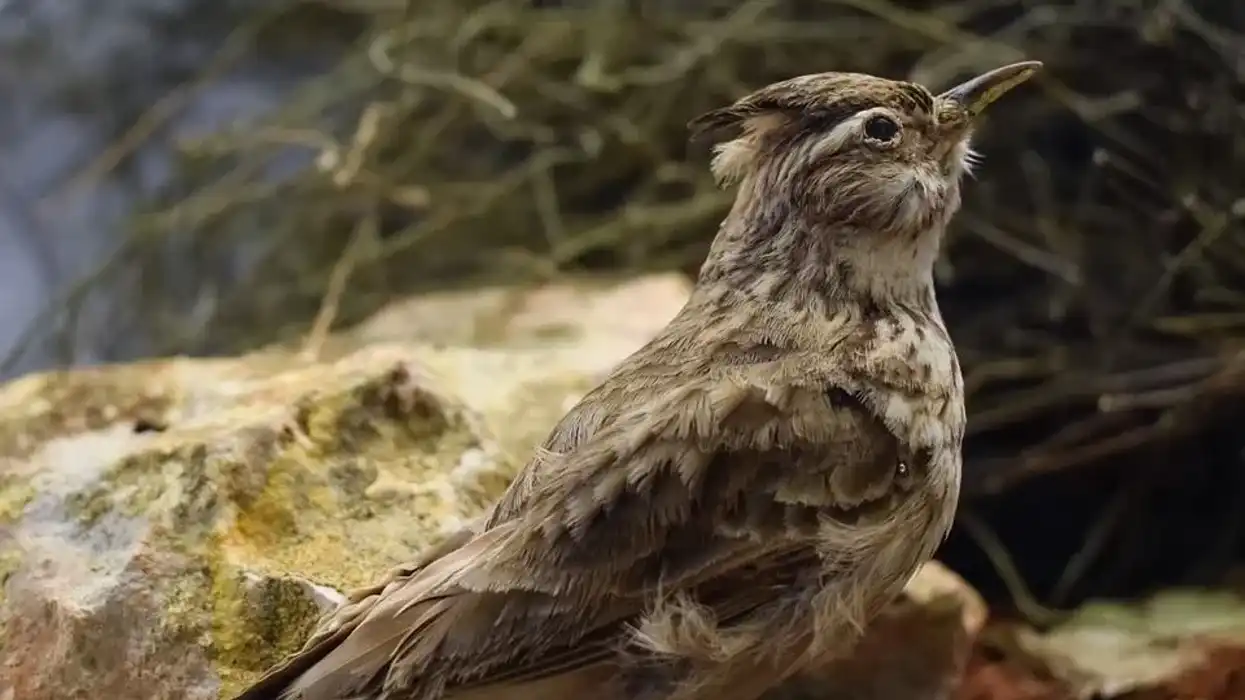For centuries owls have always generated great interest, evoking magic and mystery. The Japanese scops owl is no exception. Living only in the region of Japan, in Japanese culture, owls symbolize good luck and fortune.
With a deep intense gaze and a nocturnal nature, like most owls, they really are a beautiful species. They form part of the Strigidae family of which there are many owl varieties. They are also one of the smaller types of owls, but don't let that deceive you as they are excellent nighttime hunters.
If you are looking for facts about Japanese scops owls' behavior on how they live, breed, and nest, check out our fact file here for all you need to know about this magnificent owl.
What's more, if you are looking for fact files about other owls, do take a look at the tawny owl and barn owl to see how they compare!
Japanese Scops Owl Interesting Facts
What type of animal is a Japanese scops owl?
The Japanese scops owl (Otus semitorques) is a bird belonging to the genus Otus. There are 57 types of scops owls.
What class of animal does a Japanese scops owl belong to?
The Japanese scops owl belongs to the Aves bird identification class of the animal kingdom. They form part of the Strigidae family and belong to the Otus genus.
How many Japanese scops owls are there in the world?
The exact population of this species is not known.
Where does a Japanese scops owl live?
The Japanese scops owl (Otus semitorques) lives in the woodland and is found across Japan.
What is a Japanese scops owl's habitat?
The typical Japanese scops owl habitat includes mostly woodland and forest areas with plenty of trees.
Who do Japanese scops owls live with?
These birds are mostly independent and solitary creatures. They do not form flocks but, over the breeding season, these birds do form breeding pairs which they keep throughout the season. There many types of owls in Japan, including the Ryukyu scops owl and Blakiston's fish owl.
How long does a Japanese scops owl live?
The exact age of this species is not known but on average, most scops owls live for 12 years in the wild.
How do they reproduce?
These birds are monogamous throughout the breeding season. Males prepare the nests and often pick nests discarded by other birds.
The male Japanese scops owl audio call lures females to this nest and females then judge the male based on their nest-building skills and the food inside the nests. After fertilization, a female will lays eggs and incubates them for around three to four weeks.
During this period a male brings food to females while they incubate their eggs in the nest.
A Japanese scops owl baby is born naked, with minimal down feathers. Over the weeks they grow and they can fly at around four to six weeks. Females generally only lay one batch of eggs, known as a clutch, per season, unless their eggs are destroyed. They are resident breeders within Japan and do not migrate to breed.
What is their conservation status?
According to BirdLife International, these owls do not fall into the category of vulnerable populations of species. In Japan where they originate, a range of conservation work is being undertaken to continue supporting populations of this bird species.
Japanese Scops Owl Fun Facts
What does a Japanese scops owl look like?
Many people confuse identification of these owls with the slightly smaller collared scops owl (Otus bakkamoena). The Japanese scops owl is mostly a brownish-gray bird with pronounced ear tufts, a paler face, and intense red eyes. They have green feet and a greenish bill.
How cute are they?
With tufted ears and a deep intense gaze, these owlets are certainly very cute. As they get bigger and more predatory, they are perhaps not quite such cute birds.
How do they communicate?
The Japanese scops owl call is exceptionally varied, they screech and meow, hoot, and chatter. The screeching sounds they make can range from mild sounds to aggressive shrieks to warn off predators.
How big is a Japanese scops owl?
The Japanese scops owl (Otus semitorques) is 6.5 - 12 in (16.5 - 30 cm). As with most of the Strigidae owl species, they are a small size for owls and very similar size to the Indian scops owl (Otus bakkamoena).
How fast can a Japanese scops owl fly?
The speed of a Japanese scops owl (Otus semitorques) isn't known, however, members of the Strigidae family can reach speeds of up to 50 mph (80 kph).
How much does a Japanese scops owl weigh?
The Japanese scops owl (Otus semitorques) weighs approximately 7 oz (200 g), with females of the species weighing slightly less.
What are their male and female names of the species?
The Japanese scops owl (Otus semitorques) does not have a particular term for male and female birds of the species.
What would you call a baby Japanese scops owl?
A baby Japanese scops owl (Otus semitorques) is known as an owlet. This is the same term for all baby birds in the owl family.
What do they eat?
These birds eat a range of insects. They also search for small lizards, mice, bats, aquatic insects, and flying insects. They are nocturnal and search around their habitat during the night. You are more likely to hear one of these birds in Japan before seeing one of the birds of this species.
Are they poisonous?
As with most birds, they are not poisonous birds. However, the typical Japanese scops owl behavior means that it can be very territorial and protective of its young. It is best to stay well away from them during the breeding season.
Would they make a good pet?
Despite being a small bird, it's not advised to keep this owl species as a pet. Although some owls are kept in captivity, it's best left to experts. In fact, in many regions of the world is illegal to keep a pet owl.
Did you know...
Many people wonder what the difference is between the northern white-faced owl and the Japanese scops owl. The white-faced owl, formerly known as the white-faced scops owl, is found in a band of land across the African Sahara and has a unique ability to change size.
When it is faced with a larger predator, it can extend its wingspan to look bigger. It can also change its eyes to imitate the slits of an eagle's eye. This is also a camouflage survival strategy.
How did Japanese scops owls get their name?
The Japanese scops owl's name originates from the locations in which it is found in Japan. 'Scops' comes from the original Latin genus name of this small bird species. The 'Otus' part of the scientific name means 'eared owl' in Greek.
Are Japanese scops owls endangered?
Japanese scops owl population numbers are currently stable according to BirdLife International. They are also rated as Least Concern on the IUCN Red List.
In fact, their numbers are increasing, making Japanese scops owls common in Japan.
If you are looking to find the Japanese scops owl in Hokkaido in Japan, you will find that many people in Hokkaido are placing nesting boxes to encourage breeding among this bird species! Their close cousin, the Philippines scops owls, are also found to be ranked as Least Concern but they are vulnerable to habitat destruction.
Here at Kidadl, we have carefully created lots of interesting family-friendly animal facts for everyone to discover! Learn more about some other birds from our mockingbird facts and ovenbird facts pages.
You can even occupy yourself at home by coloring in one of our free printable Japanese scops owl coloring pages.










